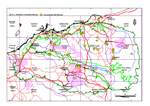Click on images
to enlarge



Photographer: B.R. Maslin

Photographer: M.W. McDonald

Photographer: B.R. Maslin

Photographer: M.W. McDonald

Photographer: B.R. Maslin
, BRM 8640, FC_sml.jpg)
Seed from one herbarium voucher. Scale in mm. Photographer: F. McCallum.
Botanical name
Acacia acradenia F. Muell., Iconogr. Austral. Acacia, dec. 11 [pl. 4, figs 1-8] (1888); J. Proc. Linn. Soc., Bot. 3: 142 (1859), pro syn. sub A. umbellata
Common name
Velvet Hill Wattle and Silky Wattle
Aboriginal name
Walypuna (Nyangumarta)
Description
Shrubs 1-4 m tall (but may reach 7.5 m outside the Pilbara), more or less 'v' -shaped and with a rather open and commonly spindly growth form, usually dividing just above ground level into a few straight, spreading to erect main stems, the crown sub-rounded with the foliage concentrated on upper half of plant and not especially dense. Bark light grey, smooth except may become longitudinally fissured towards base of stems with age. Branchlets with minute, appressed (rarely spreading) hairs that are often embedded in resin and difficult to see with the unaided eye. New shoots light green, with a slight sheen due to thin resin covering, not sticky. Phyllodes mostly obliquely elliptic to narrowly elliptic and narrowed at both ends, (4-) 4.5-11 cm long (but may reach 16 cm outside the Pilbara), 10-30 (-40) mm wide at the broadest point near the middle, coriaceous and (at least when dry) often slightly undulate, minutely hairy (more or less velvety to touch) but hairs not visible to unaided eye, pale bluish green or milky pale green (often yellowish green when under stress or dry) and sometimes with a silvery sheen; parallel longitudinal nerves numerous, fine and very close together, with 3 or more nerves rather more evident than the rest and confluent with the margin for a short distance above the base; apex acute or obtuse and terminated by a very short, brown, acute hard point. Inflorescences simple (usually in pairs within axil of phyllodes) or rudimentary racemes (raceme axes to about 1 mm long); peduncles 1-3 mm long but commonly obscured by anthers at anthesis, densely white-hairy (hairs appressed to spreading); spikes 2-6 (-7) cm long, brilliant golden, flowers crowded close together within the spike. Flowers 5-merous; calyx shortly dissected, the calyx tube hairy. Pods prolific (crowded on the receptacles), pendulous, narrowly linear, ±compressed-terete, not or scarcely constricted between the seeds, 4-9 (-11) cm long, 2.5-3.5 (-4) mm wide, thinly crustaceous, straight to slightly curved, ±velvety hairy to almost glabrous, reddish brown and often whitish scurfy on surface. Seeds longitudinal in the pods, narrowly obloid to obloid-ellipsoid, mostly 4-5 mm long, shiny, brown but often yellowish bordering the pleurogram; aril pure white (yellowish when dry).
Characteristic features
Shrubs with a rather open and commonly spindly growth form. Phyllodes mostly obliquely elliptic to narrowly elliptic, broadest near middle and narrowed at both ends, rather large (mostly 4.5-11 cm long and 10-30 mm wide), milky pale green, ±velvety to touch on account of minute hairs (which are not visible to unaided eye), with numerous, fine, closely parallel nerves. Spikes long (mostly 2-6 cm) on very short, densely hairy peduncles 1-3 mm long, the flowers close together. Pods long and narrow (mostly 4-9 cm long and 2.5-3.5 mm wide), not constricted between seeds, ±compressed-terete, straight to slightly curved, thinly crustaceous, ±velvety hairy.
Distribution and ecology
Scattered throughout northern Australia from the Pilbara and Kimberley regions in Western Australia, eastwards through Northern Territory to Queensland. In the Pilbara region A. acradenia has a scattered distribution and although not especially common it is often quite abundant in the places where it occurs. It grows on rocky plains or rocky hills, and is often associated with watercourses or other water-gaining sites, in often skeletal loam or clay outcropping or near-surface bedrock over spinifex. Regenerates from seed and may form localized colonies in areas following disturbance such as fire.
Flowering and fruiting period
Pilbara plants flower for extended periods from late March to August (sometimes in October or November), with the main flush between April and July. Plants can flower from an early age (when shrubs are only about 1 m tall). Pods with mature seeds have been collected from July to October or occasionally in April and November. Sometimes flowers, buds and mature pods occur on the plants simultaneously. Flowering and fruiting is seemingly dependent upon the frequency and intensity of rainfall.
Affinities
There is no Acacia species in the Pilbara with which A. acradenia is likely to be confused. In the past the species was frequently confounded with A. umbellata (from tropical Northern Territory and Queensland), see Pedley (1978) for discussion.
Notes
A relatively short-lived species that is killed by hot summer fires (Latz 1999), but regenerates readily from seed.
Acacia acradenia has considerable potential in arid-land horticulture and has been successfully grown in cultivation in Townsville (Simmons 1987).
Traditional aborigines of Central Australia are reported to have eaten the seeds and gum of A. acradenia and to have made spears from its stems (Latz 1999). Nyangumarta peoples from the north Pilbara and Great Sandy Desert harvested the gum as a food source and branchlets were used as ceremonial head adornments.
Conservation status
Not considered rare or endangered.
Origin of name
The botanical name is derived from the Greek acron (tip) and adenos (gland) and presumably refers to the 'gland-like' apical point that is found at the tip of the phyllodes.
References
Latz, P.K. (1999). Pocket Bushtucker: a field guide to the plants of Central Australia and their traditional uses. pp. 215. (IAD Press: Alice Springs.)
Pedley, L. (1978). A revision of Acacia Mill. in Queensland. Part 1. Austrobaileya 1(2): 75-234.
Simmons, M.H. (1987). Acacias of Australia. Volume 1, Revised Edition. pp. 327. (Nelson: Melbourne.)
